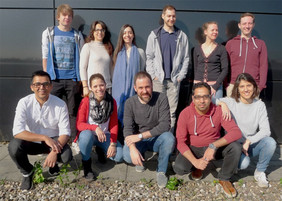
Alvaro Rada-Iglesias´s Research Team (from top to bottom and from left to right) Tore Blechwehl (PhD student), Sara de la Cruz Molina (PhD student), Agathi Karolidou (former Master Student), Milos Nikolic (PhD student), Christina Tebartz (former Postdoc), Jan Appel (lab manager), Rodrigo Osorno (postdoc), Michaela Bartusel (PhD student), Alvaro Rada-Iglesias, Rizwan Rehimi (postdoc), Patricia Respela (postdoc).
The GWAS-based Prediction Toolkit for Connecting Diseases and Cell Types enables scientists without major computational expertise to dissect the genetic basis of common and complex human disorders. The work of Alvaro Rada-Iglesias´s research team also associated with CECAD Cologne was recently published in the journal Human Molecular Genetics.
Less than 2% of the human genome encodes protein sequences, yet this coding fraction of the genome has been extensively scrutinized in search of mutations that might lead to human disease. In contrast, the much larger non-coding fraction of the human genome was long considered as “junk” DNA and received little attention.
However, this changed dramatically with the advent of genome-wide association studies (GWAS), a powerful approach to uncover the genetic basis of human common and complex diseases (e.g. diabetes, obesity, stroke, cancer).
These GWAS studies revealed that the vast majority (70-90%) of the genetic variants associated with these common disorders occur within the human non-coding genome, thus making the discovery of disease-causative genetic variants and the elucidation of the underlying pathological mechanisms far from straightforward.
On the other hand, recent advances in the genomics field have demonstrated that, far from being “junk“, the non-coding human genome is densely populated with hundreds of regulatory sequences. Amongst them, enhancers, a group of regulatory sequences that can control gene expression in a distance- and orientation-independent manner, seem to be particularly abundant and cell type-specific.
Interestingly, a significant fraction of all the genetic variants associated with common complex human diseases lies within putative enhancers. Therefore, it has been hypothesized that genetic variants occurring within enhancers might alter the regulatory properties of these sequences and lead to quantitative changes in gene expression with potentially pathological consequences.
In theory, the combination of GWAS information and enhancer maps from different human cell types and tissues should streamline the identification of causative genetic variants for common complex diseases. However, GWAS and enhancer maps are not readily accessible to the average user, typically requiring some computational skills in order to formulate testable hypothesis regarding the genetic basis of human disease.
To overcome this problem and in collaboration with Dr. Argyris Papantonis, Milos Nikolic, a PhD student in Rada-Iglesias team, developed GARLIC, a user-friendly bioinformatic toolkit that, using publically available enhancer maps and GWAS data, can be used to :
Importantly, the GARLIC toolkit includes a novel software, a dedicated database and an online-viewer which are all fully accessible to the scientific community. Hence, GARLIC provides a user-oriented, user-friendly and systematic approach that can satisfy several important needs within the field of medical genetics, thus potentially assisting in the ultimate goal of uncovering the elusive and complex genetic basis of common human disorders.
Original Publication:
Nikolić M, Papantonis A, Rada-Iglesias A. GARLIC: A Bioinformatic Toolkit for Etiologically Connecting Diseases and Cell Type-Specific Regulatory Maps.
Hum Mol Genet. 2016 Dec 22. pii: ddw423. doi: 10.1093/hmg/ddw423 [Epub ahead of print]
GARLIC viewer:
http://bifacility.uni-koeln.de/GARLIC/viewer.php
GARLIC software:
https://github.com/mnikoli/GARLIC
Dr. Alvaro Rada-Iglesis is leading a Junior Research Group at the CMMC. The Junior Research Group Program is a funding program of the CMMC, which is comparable to the Emmy Noether-Program by the German research Foundation and equivalent to an Assistant Professorship (W1) with a running period of 5 (+3) years.
http://www.cmmc-uni-koeln.de/research/junior-research-groups/
For further information, please contact:
Alvaro Rada-Iglesias, PhD
Junior Research Group Leader - Lab. of Developmental Genomics Laboratory
Center for Molecular Medicine Cologne (CMMC), University of Cologne.
phone: +49 (0) 221 478 96 988
e-mail: aradaigl[at]uni-koeln.de